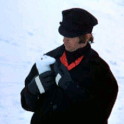Author Notes
There are few things I love cooking at home more than a roast chicken. But for entertaining (or just feeding a hungry family) I need a bigger bird and that is definitely not a turkey (see Calvin Trillin, chapter 1, verses 7 through 10). With enough sides a handsome capon will serve 6 hungry people. The only hard part is finding a fresh one. But a frozen capon is fine as long as you have two or three days for it to defrost in the refrigerator. This recipe is easily adaptable to a large “roasting” chicken, say for example an air-chilled one from Whole Foods. The idea behind air-chilled is that you are not paying for an extra 10% mass in water.
As long as you are paying attention this couldn’t be easier.
—pierino
Ingredients
-
1
8 to 9 pound capon
-
3
or 4 blood oranges (substitute valencia or other orange if necessary)
-
1
stick butter
-
Fresh tarragon
-
Sea salt plus fleur de sel for the table
-
ground pepper
-
1 cup
Homemade chicken stock (which came first?)
-
1/2 cup
Wondra superfine flour
-
cornstarch and water for a slurry
Directions
-
Heat your oven to 450F
-
Put your butter out to soften and then chop up the tarragon
-
Cut the blood oranges into quarters or eighths to fit the capon cavity. Salt the cavity and stuff in the orange pieces
-
Mash the tarragon into the softened butter. Using your freshly washed hands pull away the skin at the outside of the cavity and carefully push some of the butter herb mixture in. Don’t tear the skin.
-
Wash your hands again. Using kitchen string truss the chicken to your own preferred method. All you really want to do here is twist the wings around and keep them close to the body, and also to tighten the legs to the cavity. Be sure to close the flap. There’s a name for that which I’m not going to mention. Okay, trussed up right? Now rub the outside of the bird with remaining butter and sea salt.
-
Place Monsieur Capon in a roasting pan and put him in your oven. After 15 minutes lower the temperature to 350F. With a brush (silicone) baste the bird every 20 minutes or so with the buttery juices that are now dripping out. It’s likely to take about an hour and a half to cook. But you will need to check the temperature to be sure it reaches 160?. See notes below on instant reads.
-
When the flesh tested away from the bone reaches 160? remove the capon to a platter and tent with aluminum foil for at least 15 minutes. It will get a “heat boost” and the juices will settle back in.
-
While it’s resting make your “gravy”. Put your roasting pan on a gas burner and add the Wondra superfine flour. Scrape around a bit so that the flour colors. Add the chicken stock, and continue to stir. Make a slurry with water and corn starch, about half and half. Set that aside. Strain the stock and dripping mixture. Whisk in the slurry which will give it body and shine. Carve and serve.
-
Notes: I’m almost as bad a therma-geek as Alton Brown. I check temperatures with a laser (no two oven dials are calibrated exactly---you can be off by 25?). I also use a Thermapen to test the meat. After using one for ten years I was happy to see Alton pull one out. You can now buy them through kingarthurflour.com. Precise temperature control is your secret weapon as a good cook.
Standup commis flâneur, and food historian. Pierino's background is in Italian and Spanish cooking but of late he's focused on frozen desserts. He is now finishing his cookbook, MALAVIDA! Can it get worse? Yes, it can. Visit the Malavida Brass Knuckle cooking page at Facebook and your posts are welcome there.

See what other Food52ers are saying.